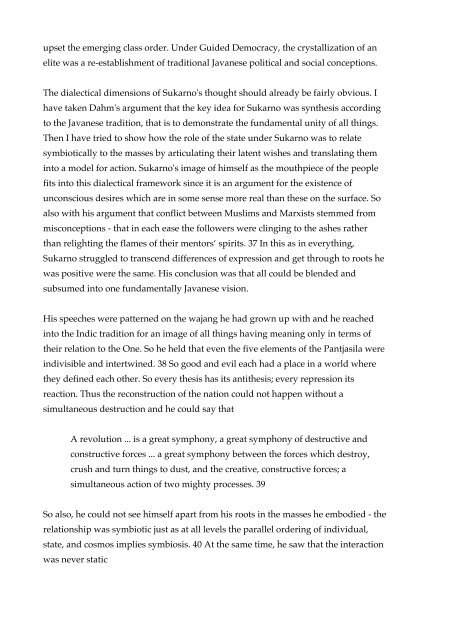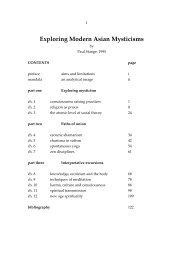Javanese Mystical and Marxist Dialectics - Paul Stange
Javanese Mystical and Marxist Dialectics - Paul Stange
Javanese Mystical and Marxist Dialectics - Paul Stange
Create successful ePaper yourself
Turn your PDF publications into a flip-book with our unique Google optimized e-Paper software.
upset the emerging class order. Under Guided Democracy, the crystallization of anelite was a re-establishment of traditional <strong>Javanese</strong> political <strong>and</strong> social conceptions.The dialectical dimensions of Sukarno's thought should already be fairly obvious. Ihave taken Dahm's argument that the key idea for Sukarno was synthesis accordingto the <strong>Javanese</strong> tradition, that is to demonstrate the fundamental unity of all things.Then I have tried to show how the role of the state under Sukarno was to relatesymbiotically to the masses by articulating their latent wishes <strong>and</strong> translating theminto a model for action. Sukarno's image of himself as the mouthpiece of the peoplefits into this dialectical framework since it is an argument for the existence ofunconscious desires which are in some sense more real than these on the surface. Soalso with his argument that conflict between Muslims <strong>and</strong> <strong>Marxist</strong>s stemmed frommisconceptions - that in each ease the followers were clinging to the ashes ratherthan relighting the flames of their mentors‘ spirits. 37 In this as in everything,Sukarno struggled to transcend differences of expression <strong>and</strong> get through to roots hewas positive were the same. His conclusion was that all could be blended <strong>and</strong>subsumed into one fundamentally <strong>Javanese</strong> vision.His speeches were patterned on the wajang he had grown up with <strong>and</strong> he reachedinto the Indic tradition for an image of all things having meaning only in terms oftheir relation to the One. So he held that even the five elements of the Pantjasila wereindivisible <strong>and</strong> intertwined. 38 So good <strong>and</strong> evil each had a place in a world wherethey defined each other. So every thesis has its antithesis; every repression itsreaction. Thus the reconstruction of the nation could not happen without asimultaneous destruction <strong>and</strong> he could say thatA revolution ... is a great symphony, a great symphony of destructive <strong>and</strong>constructive forces ... a great symphony between the forces which destroy,crush <strong>and</strong> turn things to dust, <strong>and</strong> the creative, constructive forces; asimultaneous action of two mighty processes. 39So also, he could not see himself apart from his roots in the masses he embodied - therelationship was symbiotic just as at all levels the parallel ordering of individual,state, <strong>and</strong> cosmos implies symbiosis. 40 At the same time, he saw that the interactionwas never static




